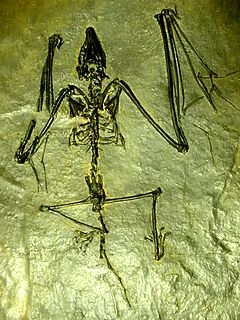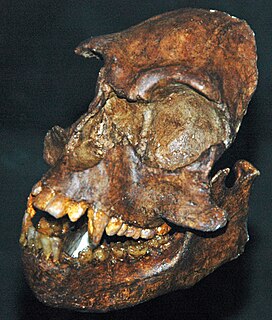
Tamias is a genus of chipmunks within the tribe Marmotini of the squirrel family. It includes a single living species, the Eastern chipmunk The genus name Tamias means "treasurer", "steward", or "housekeeper", which is a reference to the animals' role in plant dispersal through their habit of collecting and storing food for winter use.

Eutamias is a genus of chipmunks within the tribe Marmotini of the squirrel family. It includes a single living species, the Siberian chipmunk. The genus is often treated as a subgenus of Tamias, which is now restricted to the eastern chipmunk of North America. Neotamias, which now includes the western North American chipmunks, has also been included in Eutamias.

The rodent family Diatomyidae, found in Asia, is represented by a single known living species, Laonastes aenigmamus.

Diatomys is an extinct rodent genus known from Miocene deposits in China, Japan, Pakistan, and Thailand. The fossil range is from the late Early Miocene to the Middle Miocene.

Miniopterus, known as the bent-winged or long winged bats, is the sole genus of the family Miniopteridae. They are small flying insectivorous mammals, micro-bats of the order Chiroptera, with wings over twice the length of the body. The genus had been placed in its own subfamily among the vespertilionid bats, as Miniopterinae, but is now classified as its own family.
Ia is a genus of bat in the family Vespertilionidae. It belongs to the subfamily Vespertilioninae and has been placed in the tribe Vespertilionini. In the past, it has also been considered a synonym or subgenus of the genera Pipistrellus or Eptesicus, which used to contain many more species than they do now. Ia comprises a single living species, the great evening bat (I. io) of eastern and southeastern Asia, and one extinct fossil species, I. lanna, from the Miocene epoch in Thailand. Another living species, I. longimana, was recognized in the past, but it is no longer considered a valid species distinct from the great evening bat.
Megapedetes is a genus of fossil rodents related to the springhare and other species of the genus Pedetes, with which it forms the family Pedetidae. At least four species are known, which ranged through Africa, southwestern Asia, and southeastern Europe from the Miocene to the Pliocene. The genus was larger than Pedetes.
The MN zonation is a system used to correlate mammal-bearing fossil localities in the Miocene and Pliocene epochs of Europe. It consists of sixteen consecutive zones defined through reference faunas, well-known sites that other localities can be correlated with.
Miniopterus zapfei is a fossil bat in the genus Miniopterus from the middle Miocene of France. First described in 2002, it is known only from the site of La Grive M, where it occurs with another fossil Miniopterus species, the smaller and more common Miniopterus fossilis. M. zapfei is known from five mandibles and an isolated fourth upper premolar (P4). The fourth lower premolar is more slender than in M. fossilis and the cingulum shelf surrounding the P4 is less well-developed than in living Miniopterus. The length of the first lower molar is 1.57 to 1.60 mm.
Miniopterus fossilis is a fossil bat in the genus Miniopterus. It existed in what is now Slovakia during the Miocene period. It was first named by Zapfe in 1950.
Lagrivea is a fossil genus of squirrel from the Middle Miocene of France. The single species, L. vireti, is known from three mandibles and two isolated teeth. All come from the fissure filling of La Grive L5, part of the La Grive-Saint-Alban complex in Saint-Alban-de-Roche, southeastern France. Lagrivea was a large tree squirrel with flat lower incisors and a large, triangular fourth lower premolar (p4). Each of the four cheekteeth bears a deep basin in the middle of the crown. The m3 is about rectangular in shape, but rounded at the back. Although m1 and m2 have two roots, m3 has three.
? Nycticebus linglom is a fossil strepsirrhine primate from the Miocene of Thailand. Known only from a single tooth, an upper third molar, it is thought to be related to the living slow lorises, but the material is not sufficient to assign the species to Nycticebus with certainty, and the species name therefore uses open nomenclature. With a width of 1.82 mm, this tooth is very small for a primate. It is triangular in shape, supported by a single root, and shows three main cusps, in addition to various crests. The absence of a fourth cusp, the hypocone, distinguishes it from various other prosimian primates.
The Mae Long Formation in the Li Basin is a fossil site in Lamphun Province, Thailand. The fossils found are thought to date to the late Early Miocene, about 18 million years ago, corresponding to the European zone MN 4.
Tupaia miocenica is a fossil treeshrew from the Miocene of Thailand. Known only from a single tooth, an upper first or second molar, it is among the few known fossil treeshrews. With a length of 3.57 mm, the tooth is large for a treeshrew. At the back lingual corner, the tooth shows a small cusp, the hypocone, that is separated from the protocone in front of it by a narrow valley. The condition of the hypocone distinguishes this species from various other treeshrews. In addition, the presence of a well-developed but simple mesostyle is distinctive.

Archaeonycteridae is a family of extinct bats. It was originally erected by the Swiss naturalist Pierre Revilliod as Archaeonycterididae to hold the genus Archaeonycteris. It was formerly classified under the superfamily Icaronycteroidea (disused) by Kurten and Anderson in 1980. In 2007, the spelling was corrected to Archaeonycteridae and it was reclassified to the unranked clade Microchiropteramorpha by Smith et al.. The family Palaeochiropterygidae was also merged into Archaeonycteridae by Kurten and Anderson, but modern authorities specializing in bat fossils maintain the distinction between the two.

Anapithecus is a late Miocene primate known from fossil locations in Hungary and Austria. Many Anapithecus fossils come from the site of Rudabánya, in northern Hungary, where Anapithecus lived alongside the ape Rudapithecus'. Anapithecus hernyaki is named after Mr. Gabor Hernyák, chief geologist of the Iron Ore Works of Rudabánya.
Siamoperadectes is a genus of non-marsupial metatherian from the Miocene of Thailand. A member of Peradectidae, it is the first member of its clade known from South Asia, and among the last non-marsupial metatherians.

Pliopithecoidea is an extinct superfamily of catarrhine primates that inhabited Asia and Europe during the Miocene. Although they were once a widespread and diverse group of primates, the pliopithecoids have no living descendants.
Crouzeliinae is an extinct subfamily of Pliopithecidae primates that inhabited Europe and China during the Miocene, approximately 8–14.5 million years ago - they appear to have originated in Asia and extended their range into Europe between 17 and 13 million years ago. Crouzeliines can be distinguished from the other Pliopithecoidea subfamilies on the basis of uniquely derived dental traits.

Shandongornis is an extinct genus of pheasants that lived in Miocene of Shandong province, China.








